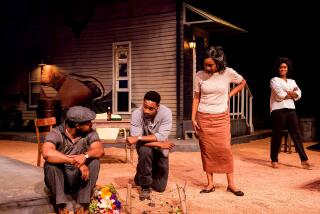The Production: How ‘The King’s Speech’ found its voice
- Share via
It’s a peculiar person — if not an unabashed sadist — who takes pleasure in someone’s stuttering, particularly at a public event. Yet when filmmaker Tom Hooper heard that Colin Firth couldn’t stop stammering while accepting an acting honor for “A Single Man,” Hooper couldn’t hide his delight.
For “The King’s Speech,” opening Nov. 26, Hooper had cast Firth as King George VI, the World War II-era English monarch who was nearly rendered a silent sovereign by a crippling speech impediment. Derek Jacobi, who costars in the film as the Archbishop of Canterbury, had warned Firth that affecting a stutter would be a hard habit to shake — Jacobi having learned the hard way after his tongue-tied performance in “I, Claudius.”
“So Colin went to an awards thing for ‘A Single Man’ in the midst of production, and he completely stammered. He couldn’t speak,” Hooper says. “And I said, ‘That’s fantastic news.’”
That Firth was able to transplant King George’s faltering diction onto his own tongue meant that audiences could see, and hear, how disabling a speech impediment can be. But if “The King’s Speech” were to become meaningful drama instead of medical monologue, it was crucial that the monarch’s relationship with his unorthodox speech therapist, Lionel Logue ( Geoffrey Rush), feel even more authentic.
“Their friendship,” says Firth, “is the biggest part of the healing story.”
American moviegoers, and more than a few British patrons, may know little about the former Duke of York, who was elevated to the throne after his older brother, Edward VIII, abdicated because he wanted to marry a twice-divorced American socialite. But any number of royal historians — and a young British boy named David Seidler — understood that King George VI was nearly paralyzed vocally. The disability was exacerbated by his wartime duty: to speak regularly to his subjects, urging solidarity as bombs rained down on England.
As a child, Seidler had been evacuated to the United States before the Blitz. The voyage — in which a convoy ship had been sunk by a U-boat — traumatized Seidler. “I was quite a profound stutterer,” he says. He followed the war’s progress on the radio, listening to King George, who by then could manage his stammer. “I heard these wonderful, moving speeches, and had heard that he had been a terrible stutterer,” Seidler says. “If he could cure himself, it gave me hope.”
Seidler went on to overcome his stutter and become a screenwriter but never forgot about the king. He was particularly interested in how the king was treated by Logue, an Australian who earlier had counseled World War I soldiers suffering from shell shock, a version of what is now known as post-traumatic stress disorder. Logue, who was not a trained speech pathologist, would briefly surface in biographies — “Blips on the radar screen,” Seidler says — but details of his treatments remained secret. “The royal family does not like talking about the royal stutterer,” Seidler says. “It was swept under the carpet.”
In the mid-1970s, Seidler wrote the king’s widow, Queen Elizabeth, asking permission to tell the story. She wrote back saying that “The memory of these events are still too painful” and that she wouldn’t accede in her lifetime. “I thought, ‘How long am I going to have to wait? One or two years?’ She wasn’t that young,” Seidler says. But the Queen Mother famously lived until age 101, 28 years after Seidler had made his inquiry.
In the intervening years, Seidler had cowritten Francis Ford Coppola’s “Tucker: The Man and His Dream,” but his credits in television had slowed to a trickle. What’s more, he had lost contact with Logue’s son, who had his father’s papers. Rather than write “The King’s Speech” as a movie, he penned it as a play — and that’s when his luck took a dramatic turn for the better.
A staged reading of the play was presented in the London borough of Islington, and in the audience was Hooper’s mother, Meredith, who is Australian. “She’d never been to a play reading in her life and didn’t expect it to be much good,” Hooper says. But as soon as she left the theater, she rang her son, who was finishing the HBO miniseries “ John Adams.” “I’ve found your next movie,” she told him. It took Hooper several months to read the play, but when he did, he called his mother back to say, “You were right.” Says Hooper: “I thought it was one of the most personal films I could make.”
Around the same time, producer Joan Lane, who had helped organize the Islington reading, decided the part of Logue would be perfect for Rush, who had won the lead actor Oscar for 1996’s “Shine.” Seidler says he had been rebuffed by the actor’s Australian agent, so Lane dispatched an Australian associate to get the actor the script through any means possible.
“It was literally in a brown paper bag on my doormat,” Rush recalls. He read it and called his Los Angeles agent. He didn’t want to be in the play, but if it were turned into a movie, Rush was in. The film’s producers flirted with casting Robert Downey Jr., Ralph Fiennes or Paul Bettany as the king before Firth jumped in and started learning how not to speak. Then, just weeks before production was set to start, art director Leon McCarthy located Logue’s diaries, notes and letters — “Like the Dead Sea Scrolls,” Firth says.
It took three decades, but “The King’s Speech” finally had found its voice.
The $15-million movie, produced by a number of British entities and the Weinstein Co., opens in 1925 as the second son of King George V (played by Michael Gambon) is set to speak before the enormous British Empire Exhibition, the remarks from Wembley carried around the globe via wireless. The microphone looms in front of the soon-to-be emperor like a hangman’s noose, and death might have been a more pleasant option, as the then Duke of York can blurt only a few jagged syllables to his global audience.
Nine years and many failed treatments later, the future Queen Elizabeth ( Helena Bonham Carter) drags her husband to Logue’s office, as unconventional in appearance with its collapsing couch and arty wallpaper as the therapist’s techniques are in practice. Logue insists on referring to the king by his nickname, Bertie, and makes small wagers with him over minor accomplishments.
Even though Logue gives his patient all kinds of vocal exercises, including a memorable scene where he encourages George VI to swear like a royal rapper, it’s clear that what he is really doing is becoming the king’s therapist-friend as a means to repair the emotional wounds that tie his tongue in knots.
“What Logue is doing is psychotherapy by stealth,” Firth says. “It’s not so much ‘Face your demons and you’ll be healed.’ It’s that he recognizes that this man has no friends, and isolation is his problem.”
Firth, Rush and Hooper say they benefited tremendously from Logue’s papers, which influenced not only the relationship between the principals but also gave the movie a few lines of dialogue.
“A lot of biographies and researchers wrote about him as dull-witted,” Firth says of the king. But in Logue’s papers, “You saw his sense of humor, irony about himself and self-mockery.”
Adds Rush: “I think there’s a greater metaphor at work. You could see this film and not think it’s a film about someone who stammers but about how do we present the best versions of ourselves.”
More to Read
The biggest entertainment stories
Get our big stories about Hollywood, film, television, music, arts, culture and more right in your inbox as soon as they publish.
You may occasionally receive promotional content from the Los Angeles Times.











